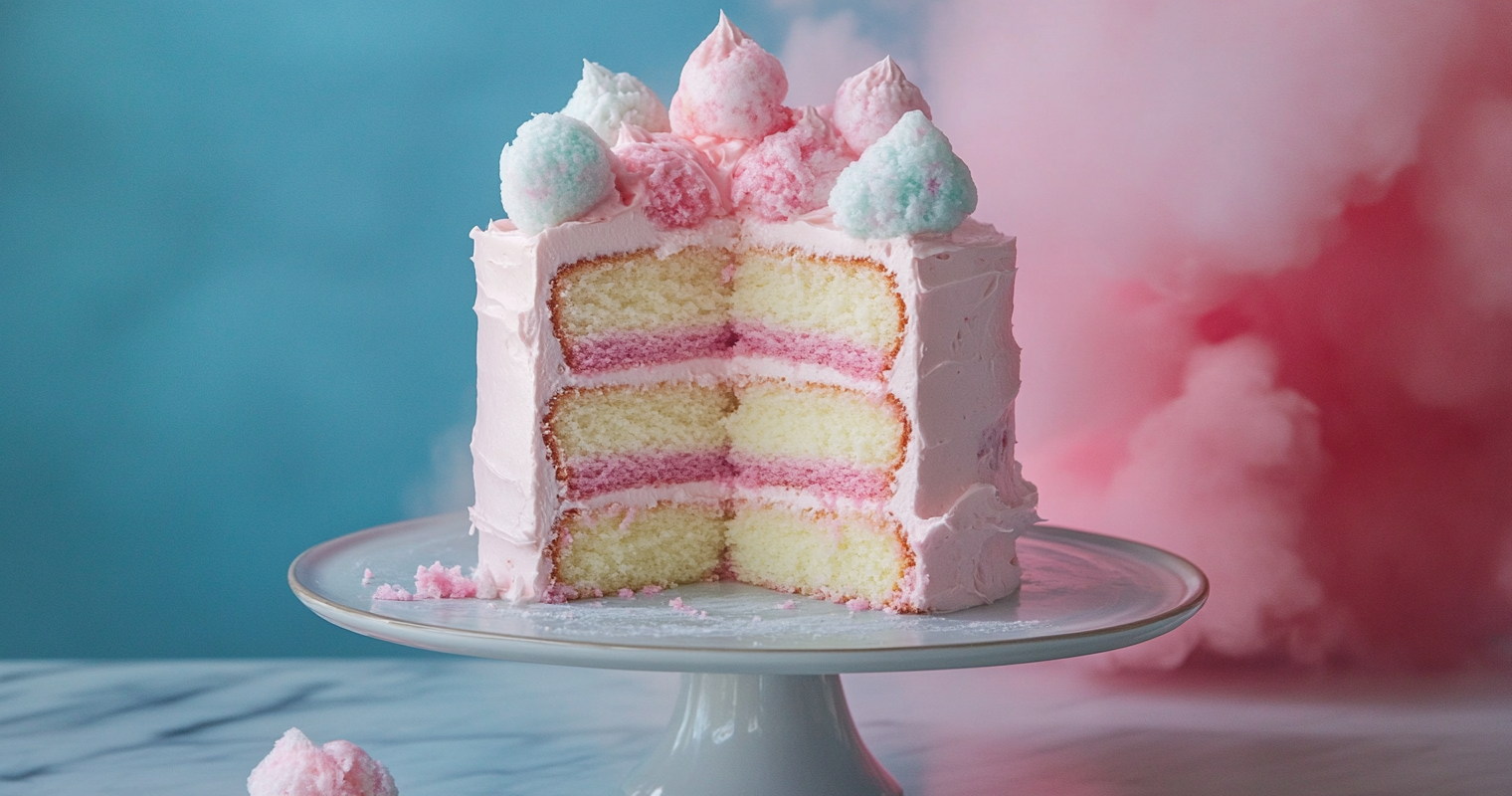Cotton candy is a popular addition to cakes for its whimsical, colorful look and airy texture. It adds a nostalgic, carnival-inspired flair to cakes that makes them perfect for birthdays, baby showers, weddings, and other special events. However, one common question that bakers and party planners often ask is: Will cotton candy melt on frosting?
In this comprehensive blog post, we will answer that question and dive deep into the science behind it. We’ll explore how environmental factors like moisture and heat affect cotton candy, how to use it on cakes effectively, and offer practical tips on decorating your cakes with cotton candy without compromising its magical appearance. We’ll also share some expert insights from seasoned bakers and provide links to additional resources that can help you create stunning cotton candy cakes.
What Happens When You Add Cotton Candy to Frosting?
Cotton candy is made primarily of sugar, which means it is extremely sensitive to moisture. The moment cotton candy comes into contact with humidity—whether from the air or from a moist surface like frosting—it begins to dissolve. While cotton candy may look great when first placed on a cake, it won’t last long if it comes into contact with moisture, heat, or humidity.
When cotton candy is placed on top of frosting, especially buttercream or whipped cream, it can begin to melt almost immediately. The frosting contains moisture, and since sugar dissolves in water, the cotton candy will shrink and lose its fluffy texture. So, while cotton candy is an eye-catching cake topper, it doesn’t have the longest shelf life once it’s placed on the cake. For this reason, it’s important to know how to properly work with cotton candy to get the best results.
Why Does Cotton Candy Melt on Frosting?
The science behind cotton candy melting on frosting is simple: sugar absorbs moisture. Cotton candy is essentially spun sugar, and its fine strands create a large surface area that makes it even more susceptible to absorbing moisture from its surroundings. When placed on a cake with frosting, the moisture in the frosting begins to break down the delicate sugar strands. This causes the cotton candy to shrink, deflate, and eventually dissolve.
Humidity also plays a role. The air’s moisture can cause cotton candy to melt, even before it touches the frosting. For example, on a hot summer day with high humidity, cotton candy can start to break down the moment it’s exposed to the air. In drier conditions, it may last a little longer, but it still has a relatively short lifespan once it is out in the open.
This sensitivity to moisture and air is why you often see cotton candy applied to cakes just before serving. To avoid melting and preserve the cotton candy’s texture and appearance, it’s crucial to time the decoration correctly.
How to Prevent Cotton Candy from Melting on Frosting
While it’s almost impossible to completely prevent cotton candy from melting once it’s on frosting, there are some techniques you can use to slow down the process. By following these tips, you can keep your cake looking picture-perfect for as long as possible.
1. Add Cotton Candy at the Last Minute
The most effective way to ensure that your cotton candy remains intact is to add it to the cake right before serving. Since cotton candy begins to melt within minutes of being exposed to moisture and air, applying it at the last moment preserves its fluffy texture and vibrant appearance.
This technique is especially useful if you’re serving the cake at an outdoor event or in a humid environment. Bring the cotton candy out from its protective storage just before presenting the cake to your guests. This will give you the best chance of maintaining its magical, airy look.
2. Use a Cake Dome or Cover
If you’ve applied cotton candy to your cake and need to store it for a short time before serving, use a cake dome or cover to shield it from the surrounding air. A cake dome helps to keep the air around the cake dry, reducing the amount of moisture that comes into contact with the cotton candy. While this won’t prevent melting altogether, it can slow down the process and help your decoration last longer.
3. Consider Frosting Options
Certain types of frosting retain less moisture than others. For instance, fondant, which has a firmer, dryer texture, might work better for cotton candy than buttercream or whipped cream, which are more moist. If you’re planning on using cotton candy as a decoration, you might want to consider using fondant as a base for the cotton candy to sit on.
Buttercream frosting is one of the most common choices for cakes, but it is relatively moist compared to other options. Whipped cream, while light and fluffy, also contains a high moisture content, which will quickly cause the cotton candy to melt.
4. Serve the Cake in a Controlled Environment
Temperature and humidity have a huge impact on cotton candy. The higher the humidity, the quicker it will melt. If possible, serve your cotton candy-topped cake indoors in a climate-controlled room. This minimizes the environmental factors that can cause the cotton candy to break down. If the event is outdoors, try to keep the cake in the shade or in an air-conditioned space until it’s time to present it.
5. Use Fresh Cotton Candy
The fresher the cotton candy, the better it will look and hold up on your cake. Cotton candy that has been sitting out for a while will already have started to absorb moisture from the air, making it more prone to melting when placed on frosting. If you’re making the cotton candy yourself, spin it as close to the serving time as possible. If you’re buying pre-made cotton candy, keep it sealed in an airtight container until you’re ready to use it.
For more insights on using cotton candy as a cake decoration, you can explore a helpful discussion on Cake Central, where experienced bakers share their tips and tricks.
Creative Ways to Use Cotton Candy on Cakes
While cotton candy has its challenges, it remains one of the most visually stunning cake decorations. Here are some creative ways to incorporate cotton candy into your cake design:
1. Cotton Candy as a Cake Topper
The most straightforward way to use cotton candy is as a topper. Pile it high on top of the cake for a dramatic, cloud-like effect. You can also use different colors of cotton candy to match the theme of your event, such as pastel pink and blue for a baby shower, or bright reds and yellows for a carnival-themed party.
2. Fairy Floss Cake
For an even more magical touch, consider making a fairy floss cake. This whimsical dessert features layers of cake topped with fluffy cotton candy, creating a dreamlike visual experience. If you’re interested in making one, check out this Fairy Floss Cake Recipe, which guides you through the steps to create a show-stopping cake.
3. Cotton Candy Accents
Rather than covering the entire cake with cotton candy, you can use it as an accent. Place small tufts of cotton candy around the edges of the cake or in between layers for a more subtle effect. This technique helps preserve the cotton candy longer, as smaller amounts are less likely to melt as quickly.
4. Cotton Candy Cupcakes
If you’re making cupcakes instead of a full-sized cake, cotton candy can be an excellent topping. A small tuft of cotton candy on top of each cupcake adds a playful touch, perfect for kids’ parties or fun events. Be sure to add the cotton candy just before serving to avoid any issues with melting.
Frequently Asked Questions
1. How Long Does Cotton Candy Last on a Cake?
Once cotton candy is placed on frosting, it typically begins to melt within 30 to 60 minutes, depending on the humidity and the type of frosting used. To maximize its lifespan, it’s best to add cotton candy just before serving.
For more details on how long cotton candy lasts on cakes and tips for storing cakes, check out How Long Does Cotton Candy Cake Last?.
2. Can You Use Cotton Candy on Any Type of Cake?
Yes, you can use cotton candy on any type of cake, but the type of frosting you choose will affect how long the cotton candy lasts. Dryer frostings like fondant are better for maintaining the cotton candy’s structure, while wetter frostings like buttercream and whipped cream will cause the cotton candy to melt faster.
3. Can You Make a Cotton Candy-Flavored Cake?
Absolutely! For a fun twist, you can make a cotton candy-flavored cake to complement the cotton candy topping. This flavor is sweet and playful, making it perfect for whimsical celebrations. If you’d like to try it out, take a look at this Cotton Candy Cake Recipe, which offers a step-by-step guide.
Conclusion
While cotton candy is a stunning and magical addition to cakes, it does have a short shelf life once exposed to moisture. When placed on frosting, especially buttercream or whipped cream, cotton candy will begin to melt due to the sugar’s reaction with moisture. However, by timing the decoration correctly and taking steps to control the environment, you can keep the cotton candy looking fresh and fluffy for as long as possible.
Remember to add the cotton candy right before serving, store the cake in a cool, dry place, and use a cake dome if necessary. With these tips in mind, your cotton candy-topped cake will be a delightful and eye-catching centerpiece at any event. For more tips on creating stunning, whimsical cakes, take a look at What Is a Fairy Floss Cake? A Whimsical Dessert Guide.

